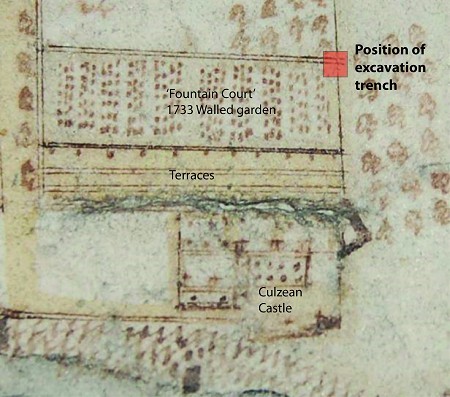Archaeologists working for Scotland’s largest conservation charity, the National Trust for Scotland, have discovered the remains of an 18th century walled garden buried below the Fountain Court in front of Ayrshire’s Culzean Castle.
The discovery was made as part of a major project to improve the drainage at the Fountain Court and to make it suitable for staging large public events. Souters Sports Ltd. is installing the new drainage and Rathmell Archaeology Ltd. has been conducting a watching brief during the groundworks.
During the excavation of a new herringbone pattern of drains and the installation of an irrigation sprinkler system, stone walls were located and recorded.
It emerged that these walls formed a large rectangular enclosure over 60m long (north-south) by 30m (east-west). As the current works presented a very rare opportunity to dig below the well-kept lawn, a larger trench was excavated to locate and expose the southern corner of the garden. Careful excavation and cleaning revealed that the wall at this point survives to over six courses, standing around 0.7m high.

This garden wall is thought to result from work undertaken by Sir John Kennedy of Culzean, 2nd Baronet, in 1733 where he extended the walled garden at the foot of the terrace walls on the east side of the castle. This garden is shown on the estate map of Culzean drawn by John Foulis in 1755.
It is likely that the walled garden functioned as an enclosed kitchen garden for the castle with fruit trees lining the south-facing walls of the terraces. The map appears to show rows of planted beds in a rectangular arrangement. This garden was abandoned in 1782 and the walls were demolished by Robert Adam’s workmen as part of the wide range of improvements carried out around the castle, leading to the iconic clifftop structure we see today.
As was the fashion in the late 18th century, the kitchen garden was moved away from the immediate view of the house and the former site was given over to wider views of the picturesque landscape. A new walled garden was built to the south-east, just out of sight of the castle and the date stone above the gate is 1786.
It is likely that a lot of the stone used for this new garden (the existing walled garden at Culzean) would have been re-used from the original one.
In the middle of the 19th century the area below the terraces was used as a bowling green before the large, ornate fountain was installed in 1876. The area has since come to be known as Fountain Court. Prior to the 16th century it is likely that this area was a narrow glen that formed a defensive barrier to the ridge upon which the medieval castle stood.
Derek Alexander, Head of Archaeological Services for the NTS said:
“It is so exciting to see part of the original walled garden at Culzean.
“Although it was marked on the estate map, until now we never knew that any of it survived below the immaculate turf of the Fountain Court.
“This work has given us the perfect opportunity to explore a hidden aspect of Culzean’s past and, once the lawn is re-seeded, I can’t imagine the gardeners will want us digging more holes!”
Culzean Castle in Maybole is one of Scotland's most popular visitor attractions and with its dramatic clifftop setting, Robet Adam Architecture, fascinating ...
View attraction